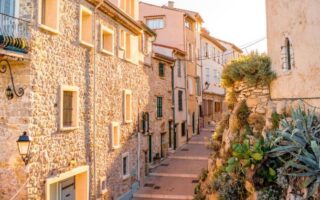Electricity in Your French Property: Energy Providers, Tariffs, and Fittings
Essential Reading


Whether you’re a homeowner or renter, choosing the best French electricity provider and electricity tariff can make a big difference to your monthly outgoings. From meter readings and paying your bills to foreign electric devices—here’s everything you need to know about electricity in your French property.
Electricity in France: An Introduction
Electricity is big business in France. France is the world’s largest net exporter of electricity and a key supplier for neighbouring countries, including Spain, Italy, Germany, and the UK. Unlike other western countries, France generates some 70% of its electricity from nuclear power, with around 12% coming from hydroelectric power stations and around 17% coming from recycled nuclear fuel*. All of this means that France’s electricity is among the cheapest in Europe—good news for homeowners.
The vast majority of electricity in France is supplied by the state-owned EDF (Electricité de France), although there are now also several other electricity providers, and it is worth shopping around for the best deal (more about that in a moment).
First, let’s get into the basics of setting up and connecting electricity at your French home.
Setting up Electricity in Your French Home
Whether you’ve just signed the Acte de Vente on your French property or are renting an apartment, one of the first steps when moving into your new home will be to set up your electricity.
Moving Home: Setting Up Your Electricity
When moving into a new house, you should contact EDF or your chosen electricity provider at the earliest opportunity (or a minimum of two days prior to moving). Request a meter reading (relevé de compteur) and a date for you to take over the existing contract or (if you opt for a different energy provider) start your new contract.
This can be set up over the phone or online (here’s the link to the EDF application page), and you will need the details of your property, your move-in date, and ideally, the Point de Livraison (PDL), which is the 14-digit meter number found on electricity bills (you should ask the previous occupant or seller for this).
When you set up your contract, expect to be asked for ID and proof of ownership or residence (such as your rental contract or Compromis de Vente), your residence permit (carte de séjour) if you have one, and your bank account RIB. To change an existing electricity supply into your name, there is an ‘access’ fee (frais d’accès), currently €18.46, including tax with EDF. If you are not resident in France, you may be required to pay a deposit, which is refundable against future bills.
Similarly, if you are leaving a French property, you must tell your current electricity provider a minimum of two days before you leave, and you should also organise a meter reading.
Connecting Electricity in a New Property
Enedis is France’s electricity grid operator (a subsidiary of EDF), responsible for more than 95% of electricity throughout the country. This is the company that oversees connecting meters, meter readings, and power failures. If you are connecting a new house to the grid for the first time, you can request a meter connection (demande de raccordement) from Enedis. This can be done via phone or online here. EDF and other electricity suppliers will also be able to arrange this on your behalf.
Linky Smart Meters
The Linky™ Meter is a smart electricity meter that monitors your daily electricity consumption and transfers the information directly to Enedis, allowing your electricity provider to receive real-time information on your energy consumption. Essentially this means that your bills can be calculated based on your actual usage rather than an estimate based on periodic readings. By the end of 2021, 35 million Linky meters will have been installed throughout France, and these are now the standard meter for all homes moving forward.
Electricity Providers in France: Regulated and Market-Based Tariffs
As in other countries, it pays to shop around when choosing an energy provider. In France, there are two main options: choose one of the two state-owned companies providing regulated tariffs (tarifs réglementés) or choose another provider offering market-based prices (tarifs de marché).
Let’s break down both options.
EDF and Engie
EDF and Engie are France’s two state-owned energy providers, offering both electricity and gas to domestic and business properties. Historically, EDF has been responsible for supplying all of France’s electricity needs, but the market was deregulated for consumers in 2007, and since then, a number of competitors have sprung up.
It was also in 2007 that EDF was split up into two companies: EDF (offering electricity) and GDF, now Engie (offering gas). These days both EDF and Engie provide electricity and gas in competition with each other, although EDF remains the main provider of electricity, supplying a vast majority of French homes and businesses (they have more than 28 million customers in France).
In fact, EDF is so synonymous with electricity supply in France that you may be advised by your landlord or notaire to “appelez EDF” (call EDF) in order to set up your electricity—such is the assumption that you will choose this provider. Many French citizens remain sceptical of or even unaware of the many different options available, but this is slowly changing.
Regulated tariffs
EDF and Engie remain the only companies able to offer regulated tariffs (Tariff Bleu), which are fixed rates set by the French government. The benefit of these is that the rates are fixed, although there are typically annual increases and sometimes additional tax increases to account for.
Note that regulated tariffs on electricity for businesses and professional accounts have been stopped as of January 1st, 2021. However, regulated tariffs continue to be available for individuals and micro-entrepreneurs with contracts for less than 36 kVA.
Whether or not this is the best solution for your household depends upon your power and energy consumption needs (we’ll get into that later). However, if looking solely at the per-unit rate (kWh), you will likely find more competitive prices from the market-based tariffs.
For expats in France, one notable benefit of EDF is that they have a comprehensive English-language service. This includes an English website, English-speaking advisors on call six days a week, and customisable payment options which do not penalise non-residents. All of these points make them a strong contender for second-home owners or those for whom speaking French is a challenge.
Other Energy Providers
All of the other energy providers in France provide market-based tariffs, which means the prices are subject to fluctuations in the energy market. In practice, this means that prices are often lower than those of EDF, at least for the average domestic household. Some providers also offer fixed-rate contracts for an initial period, allowing for a certain amount of security over rates, and there is often a range of options available.
Along with competitive prices, alternative energy providers may be a good choice for those concerned about using green and renewable energy options. Some also provide additional deals, promotions, or incentives, so it’s a good idea to compare multiple providers before making your choice.
Alternate and Green Energy Providers
There are many different electricity providers now, and you may also find small, local companies offering competitive rates. Here are some of the most notable:
- Total Direct Energie: With more than 5 million nationwide clients, this is the number one competitor to the state-owned suppliers. Total Direct Energie’s electricity offers are all guaranteed to be below the pre-tax regulated tariff (at the time of subscription), and electricity is sourced from 100% renewable sources. Offers include a one-year fixed-rate contract.
- OHM Energie: Electricity is sourced from 100% renewable sources and there are some competitive offers, encouraging customers to reduce their energy consumption and save money.
- Leclerc énergies: In conjunction with the supermarket chain, customers can use the mobile app to check your consumption and the market rate, and adjust their usage according to fees. Prices follow the market rate, and an added bonus is that you can earn money on your E.Leclerc card as you pay your bills, meaning you save money on your groceries too.
- Alterna: Alterna has a choice of electricity and green energy for both individuals and businesses, and rates are based on supplier costs rather than the regulated tariffs.
- Proxelia: This one is for those based in the North of France only. Proxelia provides domestic and business contracts with guaranteed percentage reductions against the regulated tariff.
- ilek: Among the most innovative and transparent green energy providers on the market, ilek allows you to choose your energy source: hydro, wind, or solar, and also encourages customers to install their own solar panels.
- Plüm Energie: specialising in green and locally sourced energy, Plum offers some innovative ways to monitor and conserve your energy usage (and therefore reduce your bills). It’s also one of few suppliers that allow second-home owners to pay using a European (non-French) bank account.
- Enercoop: A green energy cooperative where electricity is provided by local producers from 100% renewable sources. Rates are based on production costs and tend to be a bit higher, but it’s one of the greenest energy providers on the market and recognised as ‘truly green’ by Greenpeace.
- Planète Oui: 100% green electricity (also recognised by Greenpeace) with rates that match or beat the regulated tariffs. Rates are best for those with small energy consumption needs (3-6 kVA).
- Mint Energie: Manage your energy consumption via their real-time app and save up to 15% on regulated tariffs (depending on your energy consumption). Electricity is 100% green and local, plus a percentage goes to reforestation projects.
- Greenyellow: In conjunction with the supermarket chain Casino (Monoprix), Greenyellow offers green electricity at competitive prices and real-time app access to monitor your subscription.
How to Choose an Electricity Supplier in France: Rates and Tariffs
The amount you pay for your electricity will not only be determined by the electricity provider you choose but by the power supply required (the amount of electricity delivered to your home) and also by the tariff you choose.
Power Consumption
The first thing you will need to work out is the power supply you need for your home. Most domestic electricity providers have options that range from 3kVA up to 36kVA, and your standing charge (abonnement) will depend on this rate of supply, as well as the tariff you choose.
The power setting is usually shown on your meter (compteur), and possible ratings are 3, 6, 9, 12, 15, 18, 24, 30, and 36 kVA.
To calculate the power supply required, make a list of all the electrical appliances you have (plus any you intend to install, such as an electric shower or dishwasher) and the power consumption of each. Add the power consumption of the appliances that you’re likely to operate simultaneously to obtain the total number of kilowatts required. The lowest rates (3 and 6kVA.) don’t cater for electric heating, which needs a power supply of 9 kVA to 18 kVA depending on the heating system. Generally speaking, a small apartment might manage on a 3kVA, while most family homes will need a minimum of 9kVA.
Tariffs
Many electricity suppliers provide different tariffs, which typically follow one of three options:
Basic Tariff: Electricity rates stay the same 24/7, and you pay a monthly fee based on your usage.
Peak/Off-peak Tariff (option heures pleines/heures creuses): Electricity rates vary between a low overnight rate and a higher day rate. The low rate is generally used to heat hot water and charge night storage heaters. Be sure to check the exact time periods. This tariff is generally only available for 6kVA supplies or more.
‘Tempo’ Tariff (option Tempo): – The year is divided into ‘blue’, ‘white’ and ‘red’ days (jours bleus/blancs/rouges), each with different charges for peak and off-peak use as above. This means you might have low rates at weekends or higher rates during colder periods. This tariff is generally only available for 9kVA supplies or more.
Changing Electricity Providers: Can I Switch at Any Time?
Unlike many other contracts where there is often a minimum engagement period, French law prohibits electricity providers from imposing a mandatory commitment. This means your electricity contract cannot impose a minimum 12- or 24-month engagement, and you are free to switch electricity providers at any time without incurring any fees or needing to give a reason. (Note that while this law protects the domestic consumer, this may vary for business contracts with high-power consumption needs.)
If you want to switch providers, the proper procedure is to take out the contract with your new supplier and allow them to terminate the old contract on your behalf. This avoids your electricity being cut off during the transfer process and means your new provider will take care of all the formalities and paperwork.
Comparing Energy Providers
All of the above-listed suppliers allow you to estimate your power usage and tariffs online without any obligation. Another option is to use a price comparison site such as Le Lynx or Les Furets. You will need to provide information, including your postcode, telephone number and email, your PDL (if available) and annual consumption (if you know it).
Paying Your Electricity Bills
Depending on your supplier, you can typically choose to pay your electricity bills (factures) monthly or quarterly. Some suppliers offer fixed monthly rates, which will then be adjusted each quarter in accordance with your actual consumption; others bill for your actual consumption. With the installation of the new Linky meters, many suppliers will be looking to move towards billing based on your real-time consumption.
There are three elements to your French electricity bill. Firstly, the standing charge (abonnement), determined by the power supply installed. Secondly, the consumption of electricity units. TVA (Value Added Tax) is applied at 5.5% on the standing charge and 20% on the consumption.
You will also have a number of local taxes (taxes communale/départementale) and a Contribution au Service Public de l’Electricité (CSPE) are also added. These taxes are payable in the same amounts regardless of which supplier you choose.
You can pay your bills by credit card online or by phone, or by cheque, but the most common way to pay is via direct debit (prélèvement).
Plugs, Electric Devices, and Electricity Supply in Your French Home
The electricity supply in France is delivered to homes at 380/440 volts through three separate phases (not one as in some countries), which is then shared across the three phases at 220/240 volts with a frequency of 50 Hertz (cycles). Some appliances, such as large immersion heaters and cookers, draw power from all three phases.
French plugs and appliances
The French use both unearthed two-pin and earthed three-pin plugs and sockets; although two-pin sockets are now illegal, many older homes still have them. Three-pin plugs and sockets should be used for all high-power appliances (such as heaters, irons and drills). Adapter plugs are available in DIY shops, although it’s cheaper (and safer) to replace foreign plugs with the appropriate French plugs.
When buying electrical appliances, the label PROMETELEC (Association pour le Développement et l’Amélioration des Installations Intérieures) indicates that they’re safe. The safety of electrical materials is usually indicated by the French safety standards association’s initials ‘NF’ (Normes Françaises).
Light fittings
Before moving into your new home in France, be sure to check the light fittings. When moving house, most French people remove not only bulbs, but also bulb-holders, ceiling roses and sometimes even the flex, leaving you with bare (and live) wires protruding from the ceiling! This isn’t merely parsimony, but because in France, lampshades are normally sold complete with bulb-holder, flex, and ceiling rose, although these can be bought separately.
A note for UK expats: although French bulbs are similar to those sold in the UK, for example, bulb-holders (douille) have a larger diameter and won’t fit British lampshades, so if you plan to bring lampshades from the UK, make sure you bring a good supply of bulb-holders as well.
Using US electric devices in France
If you’re moving from a country with a 110V supply (such as the US), your electrical equipment will require a converter or a transformer (transformateur) to convert it to 240V, although some electrical appliances (e.g. electric razors and hair dryers) are fitted with a 110/240-volt switch. Check for the switch, which may be inside the casing, and make sure that it’s switched to 240V before connecting it to the power supply.
Converters are suitable only for appliances without circuit boards or microchips that don’t need to be plugged in for long periods (e.g. heaters, hairdryers, vacuum cleaners and coffee machines). Electronic appliances such as computers, fax machines, TVs and video/DVD players must be connected to the supply via a step-down transformer.
Add the wattage of the devices you intend to connect to a transformer and make sure that its power rating exceeds this sum. Converters and transformers can be bought in most DIY shops, although in most cases, it’s simpler to buy new appliances in France.
An additional problem with some electrical equipment is the frequency rating, which in some countries, such as the US, is designed to run at 60 Hertz (Hz) and not France’s 50Hz. Electrical equipment without a motor is generally unaffected by the drop in frequency to 50Hz (except televisions). Equipment with a motor may run with a 20 per cent drop in speed; however, automatic washing machines, cookers, electric clocks and hi-fi equipment are unusable in France if not designed for 50Hz operation.
To find out, look at the label on the back of the equipment. If it says 50/60Hz, it should work. If it says 60Hz, you might try it anyway, but first, ensure that the voltage is correct as outlined above. Bear in mind that the transformers and motors of electrical devices designed to run at 60Hz will run hotter at 50Hz, so you should ensure that equipment has sufficient space around it for cooling.
Power cuts and power stabilisers
In many rural areas, the lights often flicker and occasionally go off and come back on almost immediately (just long enough to crash your computer!). Power cuts of several minutes or hours are fairly frequent in some areas, particularly during thunderstorms, and in some departments, there’s a high risk of lightning strikes.
If you live in an area with an unstable electricity supply, it’s prudent to obtain a power stabiliser for a computer or other vital equipment to prevent it from being switched off when the power drops. If you use a computer, it’s also wise to fit an uninterruptable power supply (UPS) with a backup battery, which allows you time (around five minutes) to save your work and shut down your computer after a power failure.
If you’re worried about lightning strikes, you can install an ‘anti-lightning’ device (parafoudre) in your fuse box. (You should also keep torches, candles and preferably a gas lamp handy!)
If the power keeps tripping off when you attempt to use a number of high-powered appliances simultaneously, it probably means that the rating (puissance) of your power supply is too low. This is a common problem in France. If this is the case, you must ask the EDF to uprate the power supply to your property, although this can increase your standing charge (see below) by up to 40 per cent.
Own a Property or Second Home in France?
Our Essential Reading articles cover everything you need to know as a French homeowner from property taxes and home insurance to paying your bills. Perhaps you also need recommendations on removals to France, advice on building and renovations, or tips for managing a second home? FrenchEntrée is here to help! We can even advise on selling your French property.
Share to: Facebook Twitter LinkedIn Email



